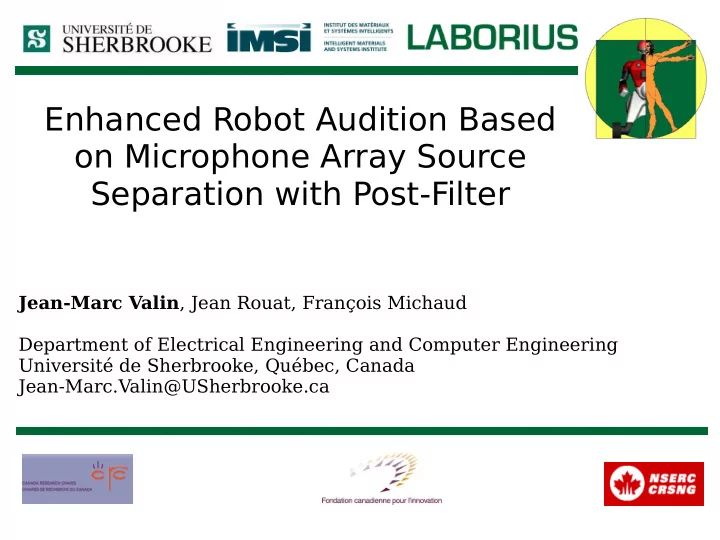

Enhanced Robot Audition Based on Microphone Array Source Separation with Post-Filter Jean-Marc Valin , Jean Rouat, François Michaud Department of Electrical Engineering and Computer Engineering Université de Sherbrooke, Québec, Canada Jean-Marc.Valin@USherbrooke.ca
Motivations The context: mobile robot and cocktail party efgect The problem: separating sound sources The solution: microphone array with both linear and non-linear processing Microphones Separated X n ( k ,l ) Sources Geometric Y m ( k ,l ) Sources ^ S m ( k ,l ) Post- source S m ( k ,l ) fjlter separation
Approach Frequency-domain processing Geometric Source Separation (GSS) Minimize leakage under constraints Adapted for real-time processing Post-fjlter Cancels remaining interferences Based on Ephraim and Malah estimator Handles both stationary and non-stationary noise/interference
Geometric Source Separation Frequency domain: Constrained optimization Minimize correlation of the outputs: Subject to geometric constraint: Modifjcations to original GSS algorithm Instantaneous computation of correlations Stochastic-gradient descent
Post-Filter Overview Noise estimate as the sum of two components (stationary + transient)
Background Noise Estimation Minima-Controlled Recursive Average (Cohen) Noise estimate is adapted during quiet periods Applied for each source of interest Initial estimate provided directly from the microphones
Interference Estimation Source separation leaks Incomplete adaptation Inaccuracy in localization Reverberation Imperfect microphones Estimation from other separated sources
Suppression Rule Ephraim & Malah spectral estimator Gain is modifjed to take into account probability of source being present (Cohen)
Experimental Setup Array of 8 inexpensive microphones on a Pioneer2 robot Automatic localization Noisy conditions 350 ms reverberation time
Results (Signal-to-Noise Ratio) Three voices recorded separately so clean signal is available
Results (spectrograms) Input GSS Post-fjlter output Reference
Results (recognition with post-fjlter) Japanese isolated word recognition (SIG2 robot) 3 simultaneous sources 200 word vocabulary 90 degrees separation mixed GSS only GSS+pf right 66% 71% left 15% 21% center 41% 53% 14% reduction in error rate
Conclusion Geometric Source Separation Real-time minimization of leakage Source separation post-fjlter Interference estimated using other sources Future work Robustness to reverberation original processed Better integration with speech recognition Using the post-fjlter to estimate ASR feature reliability
Questions?
Recommend
More recommend